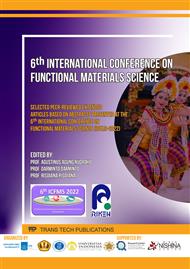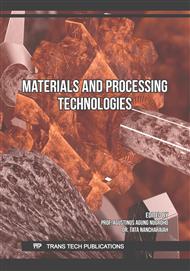[1]
T. Prahastuti and J. M. R. Rais, "Indonesia's Aluminum Industry," 2017. [Online]. Available: http://djpen.kemendag.go.id
Google Scholar
[2]
Kementerian Perindustrian Republik Indonesia, "Kemenperin Kejar Produksi Aluminium Nasional 2 Juta Ton Tahun 2025," 2018, Accessed: Jun. 17, 2022. [Online]. Available: https://www.kemenperin.go.id/artikel/18851/Kemenperin-Kejar-Produksi-Aluminium-Nasional-2-Juta-Ton-Tahun-(2025)
Google Scholar
[3]
Y. Fugane, S. Kashiwakura, and K. Wagatsuma, "Rapid detection of inclusion particles in recycled aluminum materials by laser-induced plasma optical emission spectrometry with scanning laser beam," Surfaces and Interfaces, vol. 20, p.100602, 2020.
DOI: 10.1016/j.surfin.2020.100602
Google Scholar
[4]
Widyantoro, D. Dhaneswara, J. Fajar Fatriansyah, M. Reza Firmansyah, and Y. Prasetyo, "Removal of Oxide Inclusions in Aluminium Scrap Casting Process with Sodium based Fluxes," MATEC Web of Conferences, vol. 269, p.07002, 2019.
DOI: 10.1051/matecconf/201926907002
Google Scholar
[5]
A. J. Gerrard, "Chapter 2 Literature Review," in Inclusions and Hydrogen and Their Effects on the Quality of Direct Chill Cast and Flat Rolled Aluminium Alloys for Aerospace Applications, Birmingham: University of Birmingham, 2014, p.45–50.
Google Scholar
[6]
A. J. Gerrard, "Inclusions and hydrogen and their effects on the quality of direct chill cast and flat rolled aluminium alloys for aerospace applications," 2014.
Google Scholar
[7]
R. Gallo, "Differentiating Inclusions in Molten Aluminum Baths and in Castings," 2017.
Google Scholar
[8]
X. CAO and J. CAMPBELL, "OXIDE INCLUSION DEFECTS IN Al-Si-Mg CAST ALLOYS," Canadian Metallurgical Quarterly, vol. 44, no. 4, p.435–448, Nov. 2012.
DOI: 10.1179/cmq.2005.44.4.435
Google Scholar
[9]
D. Dhaneswara, M. R. Firmansyah, Y. Prasetyo, and A. Ashari, "Comparative study of degassing method by using NaF-NaNO3-based tablet degasser, technical argon gas, and pure argon gas in aluminum casting," 2020, p.070011.
DOI: 10.1063/5.0001916
Google Scholar
[10]
D. Dhaneswara, A. F. J. Yasfi, and A. Randhiko, "Study of effect partial substitution zirconium silicate and aluminum oxide filler as refractory filler for aluminum casting," 2020, p.070010.
DOI: 10.1063/5.0001915
Google Scholar
[11]
D. Dhaneswara, J. Fajar Fatriansyah, R. Ramadhan, and A. Ashari, "The Effect of Melting Temperature Aluminum Metal Casting Using Mixed Degasser Based Sodium Fluoride and Sodium Nitrate," MATEC Web of Conferences, vol. 269, p.07001, Feb. 2019.
DOI: 10.1051/matecconf/201926907001
Google Scholar
[12]
D. Dhaneswara, J. F. Fatriansyah, and M. R. Firmansyah, "Effect of addition of sodium chloride in sodium nitrate-sodium fluoride-based degasser in aluminum casting," IOP Conf Ser Mater Sci Eng, vol. 578, no. 1, p.012066, Sep. 2019.
DOI: 10.1088/1757-899X/578/1/012066
Google Scholar
[13]
S. K. Zakaria et al., "Recycling of Wood Saw Dust Waste as Green Pore Forming Agent for Porous Ceramic," in IOP Conference Series: Earth and Environmental Science, IOP Publishing Ltd, Dec. 2020.
DOI: 10.1088/1755-1315/596/1/012017
Google Scholar
[14]
P. Bajpai, "Wood and Fiber Fundamentals," in Biermann's Handbook of Pulp and Paper, Elsevier, 2018, p.19–74.
DOI: 10.1016/B978-0-12-814240-0.00002-1
Google Scholar
[15]
E. A. Okunade, "The Effect of Wood Ash and Sawdust Admixtures on the Engineering Properties of a Burnt Laterite-Clay Brick," Journal of Applied Sciences, vol. 8, no. 6, p.1042–1048, Mar. 2008.
DOI: 10.3923/jas.2008.1042.1048
Google Scholar
[16]
D. Eliche-Quesada, F. A. Corpas-Iglesias, L. Pérez-Villarejo, and F. J. Iglesias-Godino, "Recycling of sawdust, spent earth from oil filtration, compost and marble residues for brick manufacturing," Constr Build Mater, vol. 34, p.275–284, Sep. 2012.
DOI: 10.1016/j.conbuildmat.2012.02.079
Google Scholar
[17]
S. Horisawa, M. Sunagawa, Y. Tamai, Y. Matsuoka, T. Miura, and M. Terazawa, "Biodegradation of nonlignocellulosic substances II: physical and chemical properties of sawdust before and after use as artificial soil," Journal of Wood Science, vol. 45, no. 6, p.492–497, Dec. 1999.
DOI: 10.1007/BF00538959
Google Scholar
[18]
N. Phonphuak and P. Chindaprasirt, "Types of waste, properties, and durability of pore-forming waste-based fired masonry bricks," in Eco-Efficient Masonry Bricks and Blocks, Elsevier, 2015, p.103–127.
DOI: 10.1016/B978-1-78242-305-8.00006-1
Google Scholar
[19]
E. Kurovics et al., "Preparation of particle-reinforced mullite composite ceramic materials using kaolin and IG-017 bio-origin additives," Epitoanyag - Journal of Silicate Based and Composite Materials, vol. 71, no. 4, p.114–119, 2019.
DOI: 10.14382/epitoanyag-jsbcm.2019.20
Google Scholar
[20]
M. W. Wildan and F. Marpaung, "Compressive Strength and Thermal Conductivity of Porous Mullite Ceramics," Journal of Materials Processing and Characterization, vol. 1, no. 1, p.1–8, 2020.
DOI: 10.22146/jmpc.51410
Google Scholar
[21]
F. Chargui, M. Hamidouche, H. Belhouchet, Y. Jorand, R. Doufnoune, and G. Fantozzi, "Mullite fabrication from natural kaolin and aluminium slag," Boletín de la Sociedad Española de Cerámica y Vidrio, vol. 57, no. 4, p.169–177, Jul. 2018.
DOI: 10.1016/j.bsecv.2018.01.001
Google Scholar
[22]
P. Gabbott, Principles and Applications of Thermal Analysis. Oxford, UK: Blackwell Publishing Ltd, 2008.
DOI: 10.1002/9780470697702
Google Scholar
[23]
N. v. Buchilin, V. G. Maksimov, and V. G. Babashov, "Ceramic Filters for Aluminum Melt (Review)," Glass and Ceramics, vol. 72, no. 7–8, p.246–252, Nov. 2015.
DOI: 10.1007/s10717-015-9766-7
Google Scholar
[24]
ABB Inc., "Pressure filtration melt cleanliness analyzer Prefil®-Footprinter," Quebec, 2021.
Google Scholar



